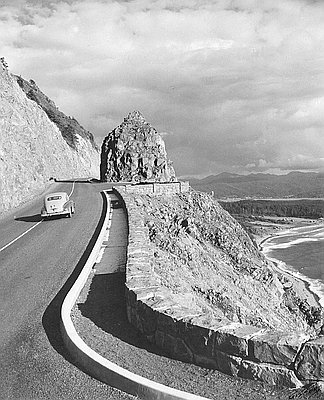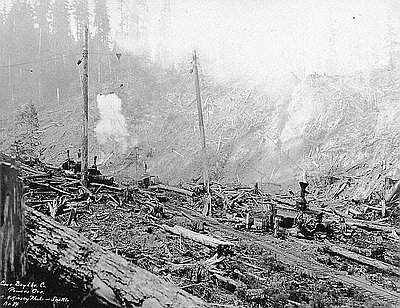- Catalog No. —
- CN 006067
- Date —
- 1968
- Era —
- 1950-1980 (New Economy, Civil Rights, and Environmentalism)
- Themes —
- Environment and Natural Resources, Science, Medicine, and Technology, Trade, Business, Industry, and the Economy
- Credits —
- Oregon Historical Society
- Regions —
- Coast
- Author —
- Al Monner, Oregon Journal
Logged-off Land near Neahkahnie Mountain, 1968
Al Monner took this 1968 photograph of clear-cut logging near Neahkahnie Mountain, located in northwest Tillamook County. Monner, who died in 1998, was a photographer for the Oregon Journal.
Lumber companies have logged intensively on private land near Neahkahnie Mountain and the nearby Nehalem River since the early twentiethth century. Many of the trees were Douglas firs, part of a coastal temperate rainforest that spanned as far north as Southeastern Alaska.
Over time, technological inventions — such as steam engines and chainsaws — allowed loggers to remove trees with increasing speed. In the 1930s, clear-cutting became the predominant logging method in the Pacific Northwest. Forestry workers argued that removing all the trees was more efficient and stimulated healthy re-growth by exposing the forest floor to sunlight. The 1941 Oregon Forest Conservation Act promoted clear-cutting, but also required lumber companies to replant seedlings.
By the late 1960s, many people began to oppose clear-cut logging. Protesters charged that removing all of the trees in an area caused erosion, damaged streams, and decreased biodiversity.
Written by Kathy Tucker, © Oregon Historical Society, 2002.
Related Historical Records
-
Highway 101, Neahkahnie Mountain
Following the route of an ancient Indian trail that linked the Clatsop and Tillamook people, Highway 101 was opened over the treacherous headland of Neahkahnie Mountain in 1940. …

-
Coos Bay Lumber Company Steam Donkeys
The steam donkey, invented in 1880, greatly increased the efficiency of logging operations in Oregon’s forests. It replaced animal labor, which could not work as fast in rainy …

-
High School Replanting Crew, Tillamook Burn, 1945
This photograph shows a group of high school boys from Hillsboro, Forest Grove, and Timber preparing to replant a section of the Tillamook Burn. It was taken by …

